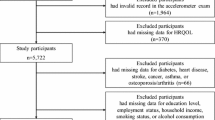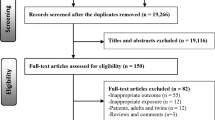Abstract
Background
The directionality of the association of physical activity (PA) and sedentary behaviour (SB) with health-related quality of life (HRQoL) remains unknown in adolescents. This study aimed to investigate the association of 2-year cumulative level of PA and SB with HRQoL and the reverse association.
Methods
We included 1445 adolescents in France from a 2-year longitudinal study with three follow-up times (PRALIMAP trial). At each follow-up, adolescents completed the International Physical Activity Questionnaire for PA and SB and the Duke Health Profile for HRQoL. Statistical analyses involved linear and logistic regressions adjusted for socio-demographic characteristics.
Results
The cumulative number of times an adolescent achieved the PA recommendations during the 2 years was associated with better physical, mental, social and general HRQoL (p for trend <0.0001). In contrast, high SB predicted low HRQoL for most dimensions except social HRQoL (p = 0.12). Combining PA and SB, the effect of recommended PA on HRQoL was offset in part by high SB. In the reverse association, high HRQoL predicted high PA (overall, vigorous, moderate and recommended PA), but was not associated with SB.
Conclusions
The association between PA and HRQoL was cumulative and bidirectional among adolescents, whereas low HRQoL seemed to be a consequence of high SB rather than a cause (cumulative but not bidirectional). Promoting recommended PA and low SB may help improve HRQoL among adolescents, with a possible virtuous cycle with regard to PA.

Similar content being viewed by others
References
Lee, I.-M., Shiroma, E. J., Lobelo, F., Puska, P., Blair, S. N., Katzmarzyk, P. T., & Lancet Physical Activity Series Working Group. (2012). Effect of physical inactivity on major non-communicable diseases worldwide: An analysis of burden of disease and life expectancy. Lancet, 380(9838), 219–229. doi:10.1016/S0140-6736(12)61031-9.
Milton, K., Macniven, R., & Bauman, A. (2014). Review of the epidemiological evidence for physical activity and health from low- and middle-income countries. Global Public Health, 9(4), 369–381. doi:10.1080/17441692.2014.894548.
Warburton, D. E. R., Nicol, C. W., & Bredin, S. S. D. (2006). Health benefits of physical activity: The evidence. CMAJ: Canadian Medical Association Journal, 174(6), 801–809. doi:10.1503/cmaj.051351.
Graff, M., North, K. E., Richardson, A. S., Young, K. M., Mohlke, K. L., Lange, L. A., et al. (2013). Screen time behaviours may interact with obesity genes, independent of physical activity, to influence adolescent BMI in an ethnically diverse cohort. Pediatric Obesity, 8(6), e74–e79. doi:10.1111/j.2047-6310.2013.00195.x.
León-Latre, M., Moreno-Franco, B., Andrés-Esteban, E. M., Ledesma, M., Laclaustra, M., Alcalde, V., et al. (2014). Sedentary lifestyle and its relation to cardiovascular risk factors, insulin resistance and inflammatory profile. Revista Española De Cardiología (English Ed.), 67(6), 449–455. doi:10.1016/j.rec.2013.10.015.
Janssen, I., & Leblanc, A. G. (2010). Systematic review of the health benefits of physical activity and fitness in school-aged children and youth. The International Journal of Behavioral Nutrition and Physical Activity, 7, 40. doi:10.1186/1479-5868-7-40.
Aman, J., Skinner, T. C., de Beaufort, C. E., Swift, P. G. F., Aanstoot, H.-J., Cameron, F., et al. (2009). Associations between physical activity, sedentary behavior, and glycemic control in a large cohort of adolescents with type 1 diabetes: The Hvidoere Study Group on Childhood Diabetes. Pediatric Diabetes, 10(4), 234–239. doi:10.1111/j.1399-5448.2008.00495.x.
Ekelund, U., Brage, S., Froberg, K., Harro, M., Anderssen, S. A., Sardinha, L. B., et al. (2006). TV viewing and physical activity are independently associated with metabolic risk in children: The European Youth Heart Study. PLoS Medicine, 3(12), e488. doi:10.1371/journal.pmed.0030488.
Fernandes, R. A., & Zanesco, A. (2010). Early physical activity promotes lower prevalence of chronic diseases in adulthood. Hypertension Research: Official Journal of the Japanese Society of Hypertension, 33(9), 926–931. doi:10.1038/hr.2010.106.
Malina, R. M. (2001). Physical activity and fitness: Pathways from childhood to adulthood. American Journal of Human Biology: The Official Journal of the Human Biology Council, 13(2), 162–172. doi:10.1002/1520-6300(200102/03)13::2<162:AID-AJHB1025>3.0.CO;2-T.
WHO|The WHO Health Promotion Glossary. (2014). WHO. Retrieved March 18, 2014, from http://www.who.int/healthpromotion/about/HPG/en/
Skevington, S. M., Sartorius, N., & Amir, M. (2004). Developing methods for assessing quality of life in different cultural settings. The history of the WHOQOL instruments. Social Psychiatry and Psychiatric Epidemiology, 39(1), 1–8. doi:10.1007/s00127-004-0700-5.
Hidalgo-Rasmussen, C. A., Ramírez-López, G., & Hidalgo-San Martín, A. (2013). Physical activity, sedentary behavior and quality of life in undergraduate adolescents of Ciudad Guzman, State of Jalisco, Mexico. Ciência & Saúde Coletiva, 18(7), 1943–1952.
Hallal, P. C., Reichert, F. F., Ekelund, U., Dumith, S. C., Menezes, A. M., Victora, C. G., & Wells, J. (2012). Bidirectional cross-sectional and prospective associations between physical activity and body composition in adolescence: Birth cohort study. Journal of Sports Sciences, 30(2), 183–190. doi:10.1080/02640414.2011.631570.
Jansen, P. W., Mensah, F. K., Clifford, S., Nicholson, J. M., & Wake, M. (2013). Bidirectional associations between overweight and health-related quality of life from 4–11 years: Longitudinal Study of Australian Children. International Journal of Obesity (2005), 37(10), 1307–1313. doi:10.1038/ijo.2013.71.
Gopinath, B., Hardy, L. L., Baur, L. A., Burlutsky, G., & Mitchell, P. (2012). Physical activity and sedentary behaviors and health-related quality of life in adolescents. Pediatrics, 130(1), e167–e174. doi:10.1542/peds.2011-3637.
Herman, K. M., Hopman, W. M., & Craig, C. L. (2010). Are youth BMI and physical activity associated with better or worse than expected health-related quality of life in adulthood? The Physical Activity Longitudinal Study. Quality of Life Research: An International Journal of Quality of Life Aspects of Treatment, Care and Rehabilitation, 19(3), 339–349. doi:10.1007/s11136-010-9586-8.
Briançon, S., Bonsergent, E., Agrinier, N., Tessier, S., Legrand, K., Lecomte, E., et al. (2010). PRALIMAP: Study protocol for a high school-based, factorial cluster randomised interventional trial of three overweight and obesity prevention strategies. Trials, 11, 119. doi:10.1186/1745-6215-11-119.
Bonsergent, E., Agrinier, N., Thilly, N., Tessier, S., Legrand, K., Lecomte, E., et al. (2013). Overweight and obesity prevention for adolescents: A cluster randomized controlled trial in a school setting. American Journal of Preventive Medicine, 44(1), 30–39. doi:10.1016/j.amepre.2012.09.055.
Omorou, A. Y., Langlois, J., Lecomte, E., Vuillemin, A., Briançon, S., & PRALIMAP Trial Group. (2015). Adolescents’ physical activity and sedentary behavior: A pathway in reducing overweight and obesity. The PRALIMAP 2-year cluster randomized controlled trial. Journal of Physical Activity & Health, 12(5), 628–635. doi:10.1123/jpah.2014-0035.
Craig, C. L., Marshall, A. L., Sjöström, M., Bauman, A. E., Booth, M. L., Ainsworth, B. E., et al. (2003). International physical activity questionnaire: 12-country reliability and validity. Medicine and Science in Sports and Exercise, 35(8), 1381–1395. doi:10.1249/01.MSS.0000078924.61453.FB.
Hercberg, S. (2003). Le programme national nutrition santé (PNNS). Archives de Pédiatrie, 10(Suppl. 1), s54–s56. doi:10.1016/S0929-693X(03)90380-0.
WHO|Global Recommendations on Physical activity for Health. (2013). WHO. Retrieved October 22, 2013, from http://www.who.int/dietphysicalactivity/factsheet_recommendations/en/index.html
Chau, J. Y., Grunseit, A. C., Chey, T., Stamatakis, E., Brown, W. J., Matthews, C. E., et al. (2013). Daily sitting time and all-cause mortality: A meta-analysis. PLoS One, 8(11), e80000. doi:10.1371/journal.pone.0080000.
Parkerson, G. R, Jr, Broadhead, W. E., & Tse, C. K. (1990). The Duke health profile. A 17-item measure of health and dysfunction. Medical Care, 28(11), 1056–1072.
Vo, T. X. H., Guillemin, F., & Deschamps, J.-P. (2005). Psychometric properties of the Duke health profile-adolescent version (DHP-A): A generic instrument for adolescents. Quality of Life Research: An International Journal of Quality of Life Aspects of Treatment, Care and Rehabilitation, 14(10), 2229–2234. doi:10.1007/s11136-005-7021-3.
Guillemin, F., Paul-Dauphin, A., Virion, J. M., Bouchet, C., & Briançon, S. (1997). The Duke health profile: A generic instrument to measure the quality of life tied to health. Santé Publique (Vandoeuvre-lès-Nancy, France), 9(1), 35–44.
Baumann, C., Erpelding, M.-L., Perret-Guillaume, C., Gautier, A., Régat, S., Collin, J.-F., et al. (2011). Health-related quality of life in French adolescents and adults: Norms for the Duke health profile. BMC Public Health, 11, 401. doi:10.1186/1471-2458-11-401.
Cole, T. J., Bellizzi, M. C., Flegal, K. M., & Dietz, W. H. (2000). Establishing a standard definition for child overweight and obesity worldwide: International survey. BMJ (Clinical Research Ed.), 320(7244), 1240–1243.
Cella, D., Bullinger, M., Scott, C., Barofsky, I., & Clinical Significance Consensus Meeting Group. (2002). Group vs individual approaches to understanding the clinical significance of differences or changes in quality of life. Mayo Clinic Proceedings, 77(4), 384–392. doi:10.1016/S0025-6196(11)61794-1.
Spengler, S., & Woll, A. (2013). The more physically active, the healthier? The relationship between physical activity and health-related quality of life in adolescents: The MoMo study. Journal of Physical Activity & Health, 10(5), 708–715.
Pedisic, Z., Grunseit, A., Ding, D., Chau, J. Y., Banks, E., Stamatakis, E., et al. (2014). High sitting time or obesity: Which came first? Bidirectional association in a longitudinal study of 31,787 Australian adults. Obesity (Silver Spring, Md.),. doi:10.1002/oby.20817.
Pearson, N., Braithwaite, R. E., Biddle, S. J. H., van Sluijs, E. M. F., & Atkin, A. J. (2014). Associations between sedentary behaviour and physical activity in children and adolescents: A meta-analysis. Obesity Reviews: An Official Journal of the International Association for the Study of Obesity, 15(8), 666–675. doi:10.1111/obr.12188.
Lacy, K. E., Allender, S. E., Kremer, P. J., de Silva-Sanigorski, A. M., Millar, L. M., Moodie, M. L., et al. (2012). Screen time and physical activity behaviours are associated with health-related quality of life in Australian adolescents. Quality of Life Research: An International Journal of Quality of Life Aspects of Treatment, Care and Rehabilitation, 21(6), 1085–1099. doi:10.1007/s11136-011-0014-5.
Hagströmer, M., Bergman, P., De Bourdeaudhuij, I., Ortega, F. B., Ruiz, J. R., Manios, Y., & HELENA Study Group. (2008). Concurrent validity of a modified version of the International Physical Activity Questionnaire (IPAQ-A) in European adolescents: The HELENA Study. International Journal of Obesity (2005), 32(Suppl. 5), S42–S48. doi:10.1038/ijo.2008.182.
Acknowledgments
On behalf of the PRALIMAP trial group, we thank all those who, through their various roles, led to the implementation of this project.
Author information
Authors and Affiliations
Corresponding author
Ethics declarations
Conflict of interest
No financial disclosures were reported by the authors of this paper.
Additional information
Serge Briançon and Anne Vuillemin have contributed equally to this work.
Rights and permissions
About this article
Cite this article
Omorou, A.Y., Langlois, J., Lecomte, E. et al. Cumulative and bidirectional association of physical activity and sedentary behaviour with health-related quality of life in adolescents. Qual Life Res 25, 1169–1178 (2016). https://doi.org/10.1007/s11136-015-1172-7
Accepted:
Published:
Issue Date:
DOI: https://doi.org/10.1007/s11136-015-1172-7




